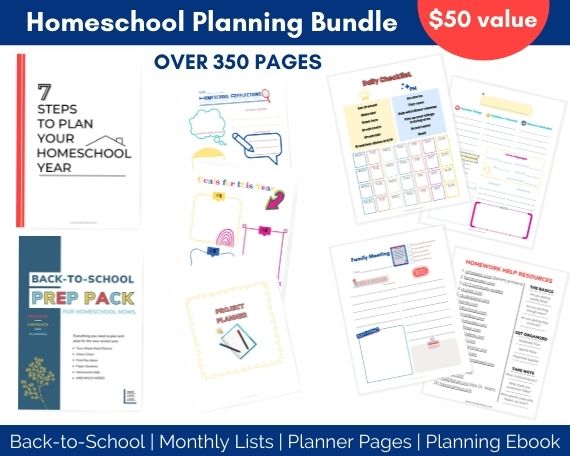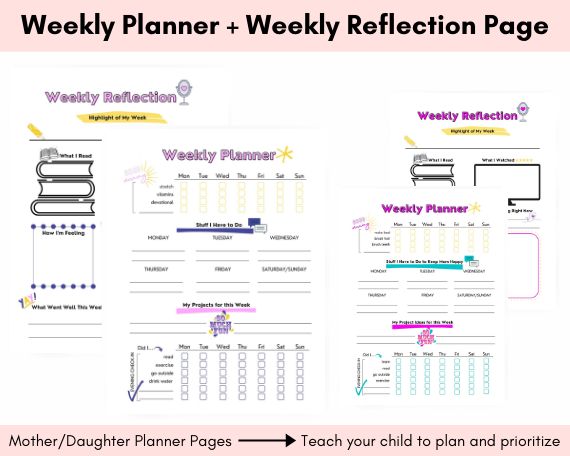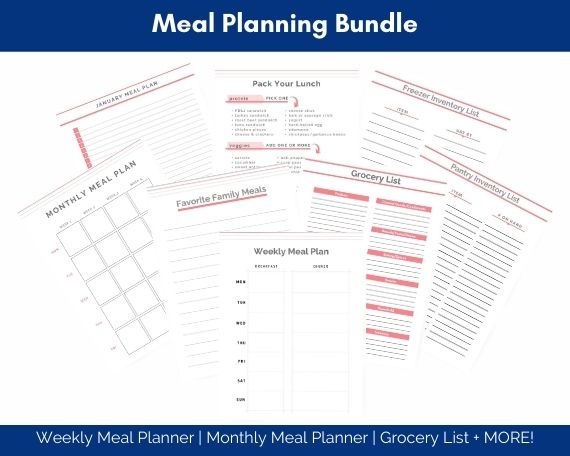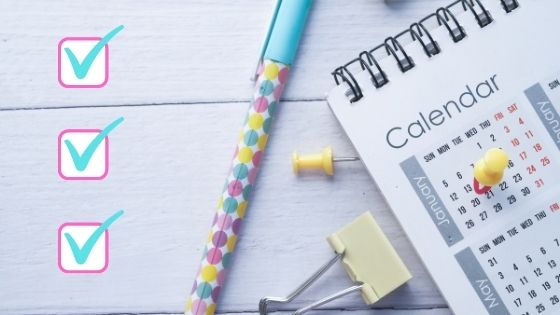9 Tips for Back-to-Homeschool Organization
Organizing your homeschool can feel intimidating if organization doesn’t come naturally to you. I want to share three keys to being organized that will help you learn how to organize your homeschool and your life.
And since it’s back-to-school time, I’ll relate these keys to ways you can organize your life for the back-to-school season and offer specific tips to help homeschool moms take action to create organized habits.
Being organized is a way of approaching your life in an intentional and step-by-step manner to create more order and less overwhelm.
Organization is a way of creating structure that enables you to find the things you need and manage the time you have.
3 Keys To Being Organized
Whether it’s organizing your homeschool or your life, there are three keys to living an organized life.
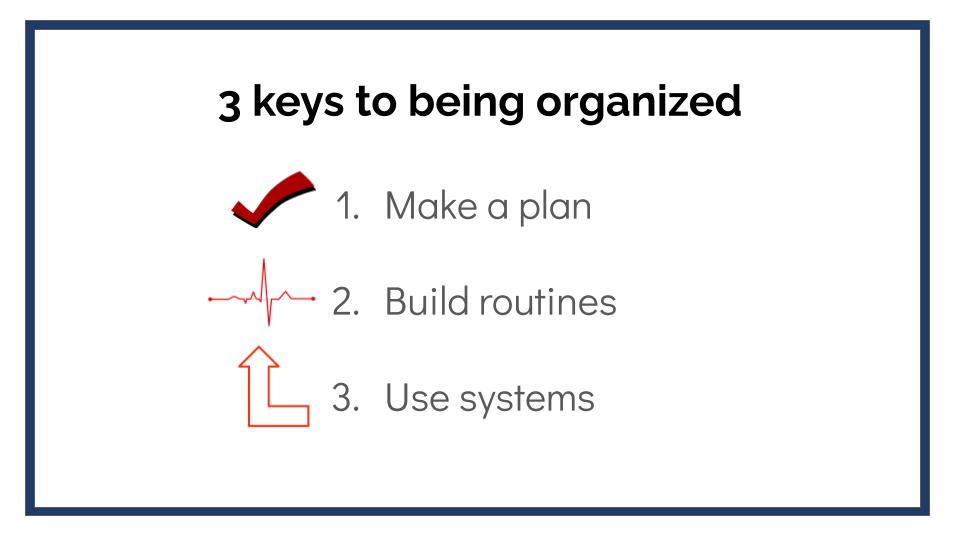
1. Make a Plan
Making a plan means to give consideration to what you need or want to do and how you will do it.
It doesn’t have to be complicated, but you should have at least some type of structure around how you’ll move forward in your homeschool and provide learning opportunities for your kids.
2. Build Routines
Again, it’s so simple, but when life is hectic, having daily, weekly, and monthly routines allows us to get important tasks done even with busy schedules and distractions.
3. Use Systems
You may think of systems as something for corporations, but a system is just an established framework for getting something done. Using a checklist is using a system.




Make a Plan to Organize Your Homeschool
Add Scheduled Activities to a Calendar
The first thing you should do when making a plan to organize your homeschool is sit down with a calendar—wall calendar, planner, Google calendar, or whatever you like to use. I personally use Google calendar for recording events and activities because it allows me to share a calendar with other family members, access it from multiple devices, and have multiple calendars that I can turn on and off with the click of a button. Use whatever works for you.
Put on your calendar every activity or event you know about for the upcoming school year.
- co-op classes
- music lessons
- sports practices
- family birthdays
- vacations
- doctor and dental appointments (make appointments now and put them on the calendar)
- school holidays if you like to generally follow the public school schedule
- church events or activities
- community events (Christmas parade, festivals)
- field trips
- scheduled work hours
TIP #1
To find field trip ideas, search the name of your city or town followed by “homeschool days.”
TIP #2
Include travel time when you add activities to your calendar.
If you have a half hour drive every time you take your kids to swim lessons or youth group, that’s actually an additional hour of your time that is not free. Knowing where your pockets of “free” time are will be important in the next step of planning.
Fit Everything Else Around Scheduled Activities
After putting all your scheduled activities on the calendar, make a list of all the activities you need or want to do on a regular basis.
- dedicated homeschooling time
- homeschool prep time or grading time, looking over completed work
- cleaning and home maintenance activities
- errands and grocery shopping
- hobbies and self-care: reading, Bible study, friends, exercise
- flexible work hours
Look for chunks of available time and assign some of those activities you brainstormed to those chunks of time.
This is a highly individualized process. You may be someone who likes to dedicate a few hours every Saturday to cleaning your whole house. Or you may prefer to check off smaller cleaning tasks each day of the week. If you don’t already have a good system for getting things done, I’d recommend grouping activities together. You’ll get in a groove of productivity rather than switching your attention back and forth from one type of task to another.
TIP #3
Set office hours for yourself. Let your kids know that you will be working during these specific hours each day or week and ask them to respect that time.
If you need focused time to work without interruptions, look for chunks of time you can carve out daily or weekly and talk to your kids about the need for them to work on schoolwork or entertain themselves without your assistance.
If your kids are old enough to work independently, have them circle, highlight, or write down things they need help with or questions they have. They can save them up rather than interrupting your time set aside for work or projects that require your focused attention.
For step-by-step help to plan your homeschool year, read:
7 Steps to Plan Your Homeschool Year
Homeschool Schedule and Lesson Planning
We can’t possibly cover everything there is to say on this topic here, but I have a few things to consider when planning your homeschool schedule and lesson planning.
Creating a Homeschool Schedule
First, think about what type of general schedule or routine you want to set. This doesn’t mean that you can’t change your schedule or ignore it from time to time. But consider what your ideal homeschool schedule would look like.
Here are a few ideas to consider to get you started:
- school every day
- four days a week with Fridays off
- school done before lunch
- daily assignments
- weekly assignments allowing kids to work ahead at their own pace
- starting at a specific time
- ending by a specific time
Homeschool Lesson Planning
Lesson planning is a huge topic, but here’s a quick way to get started. Look at your curriculum to see how many lessons are included. If you divide the number of lessons by the number of weeks you intend to do formal schoolwork, you’ll see the approximate number of days you need to work on that curriculum to finish it. Alternatively, divide the number of lessons by the number of days per week you intend to work on the curriculum to determine how many weeks you would need to get through the curriculum.
Remember: nobody says you have to finish it! You make the plan and you get to change the plan if it isn’t serving you.
This method really works regardless of how the curriculum is set up. Even if you use the number of pages you intend to cover in a book, you can divide it up that way. Let’s say you have a book you want to read over the next month. Take the number of pages divided by the number of days you intend to read it and you’ll have the number of pages to read each day.
Now for a way to keep track of your lesson plans, here are a few options to consider:
- spiral notebook (this works just fine if you want to jot down what you did each day)
- physical planner (teacher planner, specific homeschool planner)
- Google calendar
- online planner (Homeschool Planet, Common Curriculum, Planboard)
- project management software (Asana, Trello)
TIP #4
Before you make detailed plans and schedules, involve your kids. Hold a family meeting and lay out your hopes and expectations. Then get feedback from them and ask them for input.
Ask your kids whether they prefer weekly assignments or daily assignments. Would they rather do a block type of schedule, working in specific subject areas a few days each week or do a little in each subject daily?
Read: How to Hold a Family Meeting
Build Routines to Organize Your Homeschool
Routines involve doing the same thing at the same time each day or week or having an order or rhythm to the way you approach tasks. The more routines you have, the less you need to worry about decision making.
Morning Routines
Mornings are the time to take care of things that are important to you, but that have a tendency to get pushed to the side as other urgent items come up throughout the day. For me, that is daily Bible/devotional reading, prayer, and exercise.
There are two action items I suggest for beginning to create a morning routine.
First, think about what you truly want to prioritize but struggle to do consistently.
Are there things you know would make your day better, give you energy, or focus? Give that activity time first thing in the morning before your time is stolen by all the other things that demand your time throughout the day.
Second, start your day with a glass of water. Before coffee, before breakfast, before shower. Drink water. This is a tiny action you can take that will make a difference. Promise. It’s like making your bed—it’s a quick win. And yes, if I were to add a third action item, it would be to make your bed!
Read: 100 Morning Routine Ideas
Evening Routines
Good mornings start the night before, so consider implementing an evening routine to set your mornings up for success.
Here are my suggestions to consider as part of an evening routine:
- set a bedtime
- use a timer or reminder to prompt yourself to begin your evening routine
- quick tidy (clean up dishes, put away visible clutter, wipe the bathroom counter)
- planning for tomorrow (make a top priority list, look at your calendar)
- reflection (gratitude practice, memory journal, look at pictures you took, note something positive about the day)
- self-care (teeth, skincare, shower)
- lay out exercise gear or clothing
- read
- enjoy a hobby
Read: Evening Routine Ideas for Homeschool Moms
Homeschool Routines
Your kids probably like knowing what to expect MOST of the time, with a few surprises thrown in the mix to keep things exciting.
Here are a few ideas of school activities you can create routines around by regularly doing them at the same time or in the same order each day or week.
- morning basket time
- read-aloud times
- times for group learning with multiple kids
- breakfast/get ready routines
- routines for how your kids end their school day (put away books and supplies, turn in work, reflect, think about tomorow)
- morning meeting (for older kids, maybe a Monday morning meeting to go over your schedule for the week, share encouragement, and make sure everyone knows what the expectations are)
Planning Routines
Finally, let’s talk about how to have a planning routine.
Set aside specific times to think about the upcoming day, week, or month. Part of my evening routine is to plan for the following day, but pick a time that makes sense for you. Maybe that is mid-afternoon with a cup of tea. The important thing is that you make it repetitive enough that it becomes a routine.
Here are my recommendations for simple daily, weekly, and monthly planning.
DAILY PLANNING ROUTINE
Choose a time to go through the following four tasks each day:
- Brain dump
Keep a master list of everything you need or want to do. You may want to keep two separate lists for work and home if that is appropriate for your situation. Daily, add anything that comes to mind to this big list. - Scan your master list
Look through your big list for anything that becomes time-sensitive or more important to you. If you like this kind of thing, you could color code your list using highlighter or just a marker dot next to each item. Perhaps choose one color for items that have a deadline within the next month, another for items that need to be done, but don’t really have any external deadline, and another color for items that are just want to dos. - Check your calendar for appointments or activities
- Create a short list of must-do items
Using your brain dump list and your calendar, choose a few items that take top priority for tomorrow. Three is a good number here. If you get your top three done, you can always revisit your brain dump and tackle another task.
WEEKLY PLANNING ROUTINE
On a weekly basis, pick one day a week to add the following 3 things to your daily planning routine:
- Look at your calendar for the next two weeks
Do you have a doctor appointment in the middle of the day? Going on a field trip next week?
Keep upcoming events front of mind by regularly looking ahead at your calendar.
- Think about how things are going in your homeschool
Is there a concept your child isn’t getting? Now is the time to look for a YouTube video that offers an alternate explanation. Have you noticed that you aren’t getting through the material as quickly as you expected? Ask yourself if you’re trying to do too much. Print out that TpT resource you downloaded.
TIP #5
Keep a notebook handy wherever you do school to jot down anything that needs additional attention related to your homeschool.
Whether you keep your notebook on the kitchen counter, on a desk, or on the coffee table, have a go-to spot to make notes about supplies you need to purchase, concepts your child is struggling with, ideas for fun projects, or ways you can encourage your kids. As part of your weekly planning routine, look through your notebook and take care of any important items you noted.
- Meal planning
Everyone needs to eat, and it feels like ALL THE TIME. Meal planning is especially valuable during busy times. I would encourage you to create some kind of meal plan for the first month of school. Look at your calendar and determine if there are evenings you need to have meals ready for family members to eat at various times–try a crockpot meal. Maybe you want to celebrate finishing your first week of school with a fun pizza night. Be intentional–write it down. You certainly don’t need to cook every night, but make a plan for that busy time when you’re adjusting to new schedules and routines.
TIP #6
If possible, go one step further and prepare a few make-ahead meals for the freezer, ready to pull out during the first week or two of school.
I promise you’ll thank yourself later for the extra work you put in to do this now.




MONTHLY PLANNING ROUTINE
On a monthly basis, choose a time to think about some of the following questions.
- Is there anything I need to change to improve my relationship with my kids?
- How’s my relationship with my spouse? What can I do to prioritize that relationship?
- How will our family have fun together next month?
- Are there any areas my kids need to work on related to character development, habits, or attitudes?
- Any areas I need to work on?
- Are there areas where I need to set specific homeschool goals to keep myself accountable?
PLUS…
- Review your calendar for the upcoming month
Do you need to schedule time with a friend, individual time with your kids, date night, or a service project? - Plan for the fun stuff
Book you want to read, podcast to listen to, movie to watch, recipe to try, hobby to work on, supplemental fun learning in your homeschool
Read: Monthly Lists to Plan Your Year




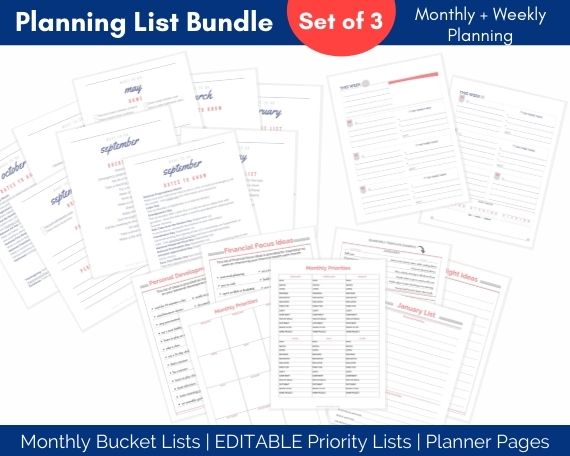

Use Systems to Organize Your Homeschool
Let’s talk about two systems that will be important for organizing your homeschool.
How to Organize Homeschool Papers
The first is a system for handling papers. In today’s context we’re talking about homeschool papers.
- Set up a mailbox for each of your kids, and get them in the habit of checking their box.
- Have a mailbox for yourself and train your kids to put completed work in your box.
- Designate a weekly time to go through projects, worksheets, essays, and anything else your kids are producing.
- Create a system for your kids to store papers: binders, magazine files, clipboards
TIP #7
Collect or create cheat sheets to help your kids easily access information they use often.
Maybe that’s a list of grammar rules, multiplication tables, algebra concepts, or a copy of the periodic table. You might include chore lists or their weekly schedule. Post them on a bulletin board or keep them in a small binder that opens flat and use a book stand to keep it upright. They can flip through to find information without taking up the surface space they need for their computer, textbooks, or worksheets.
- Keep a small tote or basket on a shelf to toss in any artwork or schoolwork you might want to keep as memorabilia.
TIP #8
Each month, choose a few memorable pieces of work and transfer to a binder as a memory book of your kids’ school experience. Save a few pieces of artwork, some writing, and anything else that will remind you of this time.
One of my daughters doodles on her math work, often funny comments about how much she hates math along with pictures covering the margins. If I find one of her comments especially amusing, I’ll add it to her binder!
How to Organize Homeschool Digital Files and Records
Another system you’ll find extremely valuable in your homeschool is a system for organizing digital files and records.
You’ve probably downloaded plenty of printables, bookmarked blogs, and saved resources you intend to use months (or maybe even years) into the future.
A logical system for organizing all this information will save you time and make it intuitive for you to find what you need.
HOW TO ORGANIZE YOUR HOMESCHOOL DIGITAL FILES
- Create a folder on your computer named HOMESCHOOL
- Inside that folder, create the following folders:
- One folder for each of your children
- Homeschool Planning
- Subject Resources
- Grade Level Resources
- General Resources
- Inside the grade level resources, add specific grade levels or ranges
- Inside the subject area resources, add specific subjects: math, science, language arts
- Keep going with this categorization as far as it makes sense for you: within your math folder, you may add fractions, algebra, long division, etc.
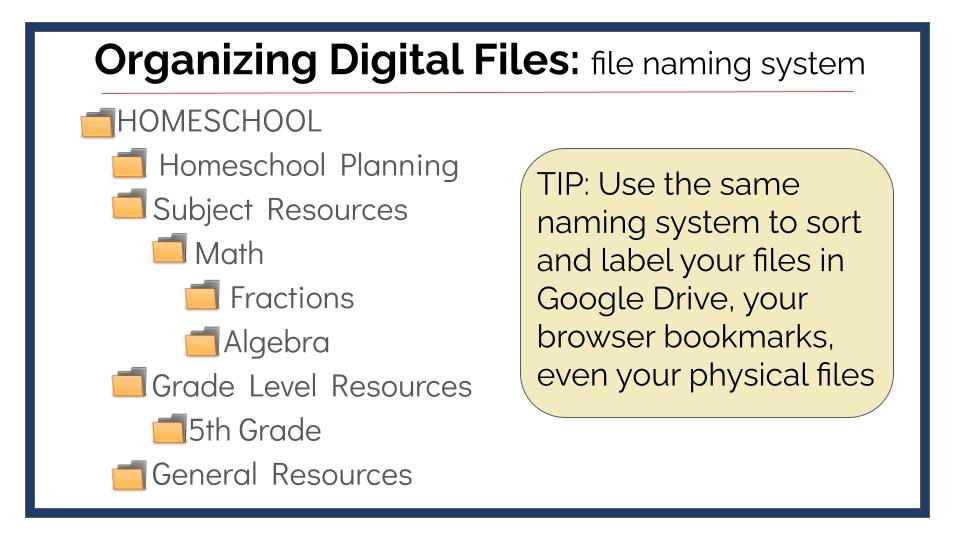

TIP #9
Use the same naming system to sort and label your files in Google Drive and the bookmarks in your browser. You’ll know exactly where to find things no matter where you’re searching. BONUS: You can use this naming convention in your physical files also!
How to Organize Homeschool
We’ve covered a lot of ground here, so I’ll give a quick recap to wrap up.



Make a Plan
- Calendar: scheduled activities
- Calendar: everything else
- Homeschool schedule and lesson planning
Build Routines
- Morning Routine: add something you want to prioritize, and drink water
- Evening Routine: create a rhythm that sets you up for a good morning
- Homeschool Routine: give your kids a flow to their days and weeks
- Planning Routine: set aside time to check your calendar and determine priorities daily, weekly, and monthly
Use Systems
- Handling Papers: mailbox for your kids and yourself, paper storage, specific times to sort through papers, place for memorabilia
- Organizing Digital Files: create a system of folders that can be used to find what you need on your hard drive, Google drive, and browser bookmarks
Visit my homeschool resources page for monthly unit study ideas, projects, and homeschool planning help!
Encouragement for Homeschool Moms
If you feel scattered and hopelessly disorganized, don’t be intimidated by the idea of getting organized.
Organization is a learnable skill.
What works for me or the homeschool mom you follow on Instagram doesn’t always work for you. What worked for you last year might not work for you this year.
Consider the way you approach planning.
Cultivate a sense of self-awareness around how you operate when you make a plan. If you know that you have a tendency to jump around to new things and can’t seem to stick to any particular system, you may want to take a little extra time and think carefully before changing your plan. Give your plan time to get familiar and comfortable before you change things up.
On the other hand, if you are someone who believes plans are meant to be followed and once you decide on a curriculum or schedule you’re sticking to it no matter what, you may need to remind yourself to be flexible when your family is clearly unhappy with your current plan.
Spend a little time considering your innate tendencies in order to be thoughtful about when you stick with the plan and when you scrap it and make a new plan.
Small improvements count a lot toward your overall feeling of calm and peace. You don’t have to overhaul your entire life and every process at once.
Take action on one item this week. Then maybe next week or the week after, you’ll feel a tiny bit of breathing room and be ready to take another action.
Organization provides freedom to spend your most precious resource—time—on your most valued priorities.





Join my mailing list to receive updates when new printable resources are added to the library, plus tips and encouragement for your organized homeschool journey.




